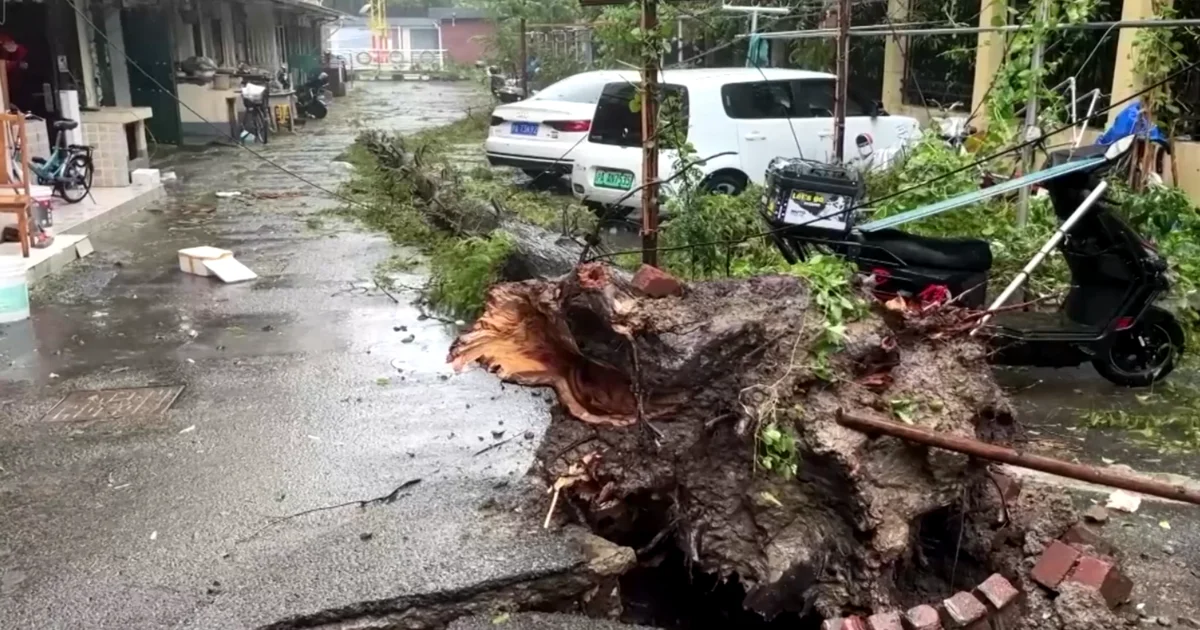Typhoon Bebinca, the most powerful storm to strike Shanghai in over seven decades, has brought the bustling metropolis to a near halt. As the Category 1 typhoon made landfall early Monday morning, the city’s 25 million residents were forced to shelter indoors as authorities mobilized emergency services to mitigate the storm’s impact. Packing wind speeds of up to 151 kph (94 mph), Bebinca is the strongest typhoon to directly hit Shanghai since Typhoon Gloria in 1949.
Typhoon Bebinca Hits Shanghai: A City on High Alert
At approximately 7:30 a.m. on September 16, Typhoon Bebinca made landfall in Shanghai, marking the city’s most significant storm event in over 70 years. With wind speeds nearing 151 kph near its eye, the storm unleashed torrential rains and gale-force winds on the region. The storm uprooted more than 10,000 trees and forced the evacuation of over 400,000 residents from vulnerable homes. By midday, state media reported only one injury, a testament to the swift response of local authorities and the preparedness of the city’s emergency teams.
Despite the city’s state of high alert, the force of Typhoon Bebinca caused widespread disruption. Parks, businesses, and major attractions such as the Shanghai Disney Resort were closed, while transportation across the city was severely affected. Over 1,400 flights were canceled, 570 trains halted and parts of the metro were suspended due to the extreme weather conditions.
Widespread Disruptions: Transportation and Tourism Take a Hit
Shanghai, one of the world’s busiest financial hubs, was significantly impacted by the storm’s effects. Airports, railways, and highways saw large-scale cancellations and closures. The city’s two airports suspended more than 1,400 flights, while metro services and passenger trains were severely limited. As the Mid-Autumn Festival holiday coincided with the typhoon, thousands of travelers faced disruptions to their plans, with major highways and elevated roads closed or operating under strict speed limits.
Tourism was also affected as several popular tourist destinations, including Jinjiang Amusement Park and Shanghai Wild Animal Park, were forced to shut down temporarily. Ferry services were halted as the storm raged across the coastal areas, leaving much of the city’s public transport system at a standstill.
Aftermath of Typhoon Bebinca: Rains Expected to Continue
As Typhoon Bebinca’s eye moved from Shanghai to the neighboring Jiangsu province by early afternoon on Monday, the storm’s impact continued to be felt across the city. Heavy rains persisted throughout the day, and authorities warned that further disruptions could occur. Although Shanghai rarely experiences direct hits from powerful typhoons—most storms land further south—Bebinca’s ferocity has placed the city on high alert. The storm comes on the heels of Typhoon Yagi, a Category 4 storm that recently tore through southern Hainan province.
Local authorities deployed more than 56,000 rescue workers to manage the storm’s aftermath and respond to emergencies. With ongoing flooding and strong winds, residents have been urged to stay indoors and avoid unnecessary travel until conditions stabilize.
FAQ About Typhoon Bebinca
When did Typhoon Bebinca hit Shanghai?
Typhoon Bebinca made landfall in Shanghai on the morning of September 16, 2024, around 7:30 a.m. local time.
How strong is Typhoon Bebinca?
Bebinca is classified as a Category 1 typhoon with maximum wind speeds reaching 151 kph (94 mph) near its eye.
Why is Typhoon Bebinca significant for Shanghai?
Typhoon Bebinca is the strongest tropical cyclone to directly hit Shanghai since Typhoon Gloria in 1949. The city is rarely subjected to direct hits from powerful typhoons, which typically land further south in China.
What are the main disruptions caused by Typhoon Bebinca in Shanghai?
The storm caused widespread travel disruptions, with over 1,400 flight cancellations and 570 train suspensions. Popular tourist attractions like the Shanghai Disney Resort and public parks were closed, while roads and highways were either shut down or operated under special restrictions.
How many people were affected by Typhoon Bebinca in Shanghai?
More than 400,000 people were evacuated from at-risk areas, and emergency services deployed over 56,000 rescue workers to respond to the storm.
What is the status of Typhoon Bebinca now?
As of early Monday afternoon, the eye of the storm had crossed into Jiangsu province, but heavy rain and strong winds were expected to continue affecting Shanghai throughout the day.
